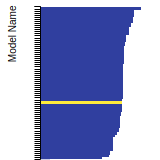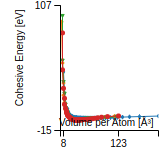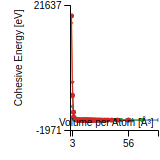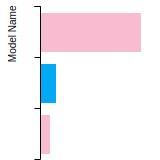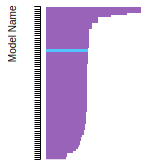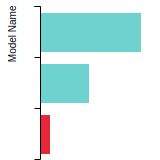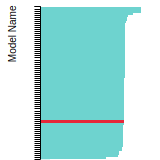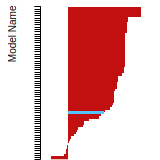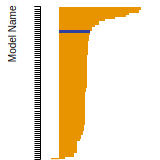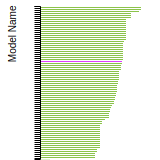 EAM_Dynamo_MendelevFangYe_2015_AlSm__MO_338600200739_000
EAM_Dynamo_MendelevFangYe_2015_AlSm__MO_338600200739_000
| Title
A single sentence description.
|
Finnis-Sinclair potential (LAMMPS cubic hermite tabulation) for the Al-Sm system developed by Mendelev et al. (2015) v000 |
|---|---|
| Description
A short description of the Model describing its key features including for example: type of model (pair potential, 3-body potential, EAM, etc.), modeled species (Ac, Ag, ..., Zr), intended purpose, origin, and so on.
|
Finnis-Sinclair potential for the Al-Sm system developed by Mendelev et al. (2015) in EAM format. The potential was developed to study the vitrification of Al rich Al-Sm alloys.
This is a semi-empirical potential for the Al90Sm10 alloy. The potential provides satisfactory reproduction of pure Al properties, the formation energies of a set of Al–Sm crystal phases with Sm content about 10%, and the structure of the liquid Al90Sm10 alloy. During molecular dynamics simulation in which the liquid alloy is cooled at a rate of 1010 K s−1, the developed potential produces a glass structure with lower ab initio energy than that produced by ab initio molecular dynamics (AIMD) itself using a typical AIMD cooling rate of 8centerdot1013 K s−1. Based on these facts the developed potential should be suitable for simulations of phase transformations in the Al90Sm10 alloy. |
| Species
The supported atomic species.
| Al, Sm |
| Disclaimer
A statement of applicability provided by the contributor, informing users of the intended use of this KIM Item.
|
None |
| Content Origin | NIST IPRP (https://www.ctcms.nist.gov/potentials/Al.html#Al-Sm) |
| Contributor |
Ellad B. Tadmor |
| Maintainer |
Ellad B. Tadmor |
| Developer |
Cai-Zhuang Wang Zhou Ye Manh Cuong Nguyen S R Wilson Mikhail I. Mendelev Feng Zhang Yang Sun Kai-Ming Ho |
| Published on KIM | 2018 |
| How to Cite |
This Model originally published in [1] is archived in OpenKIM [2-5]. [1] Mendelev MI, Zhang F, Ye Z, Sun Y, Nguyen MC, Wilson SR, et al. Development of interatomic potentials appropriate for simulation of devitrification of Al 90 Sm 10 alloy. Modelling and Simulation in Materials Science and Engineering. 2015;23(4):045013. doi:10.1088/0965-0393/23/4/045013 — (Primary Source) A primary source is a reference directly related to the item documenting its development, as opposed to other sources that are provided as background information. [2] Wang C-Z, Ye Z, Nguyen MC, Wilson SR, Mendelev MI, Zhang F, et al. Finnis-Sinclair potential (LAMMPS cubic hermite tabulation) for the Al-Sm system developed by Mendelev et al. (2015) v000. OpenKIM; 2018. doi:10.25950/2ef556c6 [3] Foiles SM, Baskes MI, Daw MS, Plimpton SJ. EAM Model Driver for tabulated potentials with cubic Hermite spline interpolation as used in LAMMPS v005. OpenKIM; 2018. doi:10.25950/68defa36 [4] Tadmor EB, Elliott RS, Sethna JP, Miller RE, Becker CA. The potential of atomistic simulations and the Knowledgebase of Interatomic Models. JOM. 2011;63(7):17. doi:10.1007/s11837-011-0102-6 [5] Elliott RS, Tadmor EB. Knowledgebase of Interatomic Models (KIM) Application Programming Interface (API). OpenKIM; 2011. doi:10.25950/ff8f563a Click here to download the above citation in BibTeX format. |
| Citations
This panel presents information regarding the papers that have cited the interatomic potential (IP) whose page you are on. The OpenKIM machine learning based Deep Citation framework is used to determine whether the citing article actually used the IP in computations (denoted by "USED") or only provides it as a background citation (denoted by "NOT USED"). For more details on Deep Citation and how to work with this panel, click the documentation link at the top of the panel. The word cloud to the right is generated from the abstracts of IP principle source(s) (given below in "How to Cite") and the citing articles that were determined to have used the IP in order to provide users with a quick sense of the types of physical phenomena to which this IP is applied. The bar chart shows the number of articles that cited the IP per year. Each bar is divided into green (articles that USED the IP) and blue (articles that did NOT USE the IP). Users are encouraged to correct Deep Citation errors in determination by clicking the speech icon next to a citing article and providing updated information. This will be integrated into the next Deep Citation learning cycle, which occurs on a regular basis. OpenKIM acknowledges the support of the Allen Institute for AI through the Semantic Scholar project for providing citation information and full text of articles when available, which are used to train the Deep Citation ML algorithm. |
This panel provides information on past usage of this interatomic potential (IP) powered by the OpenKIM Deep Citation framework. The word cloud indicates typical applications of the potential. The bar chart shows citations per year of this IP (bars are divided into articles that used the IP (green) and those that did not (blue)). The complete list of articles that cited this IP is provided below along with the Deep Citation determination on usage. See the Deep Citation documentation for more information. 
55 Citations (44 used)
Help us to determine which of the papers that cite this potential actually used it to perform calculations. If you know, click the .
USED (high confidence) F. Meng et al., “Unveiling the mechanism of phase and morphology selections during the devitrification of Al-Sm amorphous ribbon,” Physical Review Materials. 2021. link Times cited: 1 Abstract: The complex interplay between energetic and kinetic factors … read more USED (high confidence) M.-H. Yang et al., “Microstructure evolution during near-
Tg
annealing and its effect on shear banding in model alloys,” Physical Review Materials. 2019. link Times cited: 0 Abstract: By performing extensive molecular dynamics simulations, we i… read more USED (high confidence) T. Wen et al., “Development of a deep machine learning interatomic potential for metalloid-containing Pd-Si compounds,” Physical Review B. 2019. link Times cited: 30 Abstract: Interatomic potentials based on neural-network machine learn… read more USED (high confidence) Y. Sun et al., “Predicting Complex Relaxation Processes in Metallic Glass.,” Physical review letters. 2019. link Times cited: 24 Abstract: Relaxation processes significantly influence the properties … read more USED (high confidence) D. Bhattacharya et al., “Structure-property relations characterizing the devitrification of Ni-Zr glassy alloy thin films,” Journal of Applied Physics. 2019. link Times cited: 6 Abstract: The investigation of devitrification in thermally annealed n… read more USED (high confidence) P. D. Yang Sun et al., “Effects of Dopants on the Glass Forming Ability in Al-Based Metallic Alloy,” EngRN: Metals & Alloys (Topic). 2018. link Times cited: 9 Abstract: The effect of dopants on the metallic glass forming ability … read more USED (high confidence) L. Wang, J. Hoyt, N. Wang, N. Provatas, and C. Sinclair, “Controlling solid-liquid interfacial energy anisotropy through the isotropic liquid,” Nature Communications. 2018. link Times cited: 30 USED (high confidence) L. Yang, “Structures and dynamics investigation of phase selection in metallic alloy systems.” 2018. link Times cited: 1 Abstract: Different phases of metallic alloys have a wide range of app… read more USED (high confidence) L. Yang et al., “Spatially-correlated site occupancy in the nonstoichiometric meta-stable ε-Al60Sm11 phase during devitrification of Al-10.2 at.% Sm glasses,” Acta Materialia. 2018. link Times cited: 4 USED (high confidence) X. Lv et al., “A comparative study of Sm networks in Al-10 at.%Sm glass and associated crystalline phases,” Philosophical Magazine Letters. 2018. link Times cited: 2 Abstract: The Al–Sm system is selected as a model system to study the … read more USED (high confidence) L. Zhao, G. Bokas, J. Perepezko, and I. Szlufarska, “Nucleation kinetics in Al-Sm metallic glasses,” Acta Materialia. 2017. link Times cited: 24 USED (high confidence) W. P. Weeks and K. Flores, “Characteristic Structural Motifs in Metallic Liquids and Their Relationship to Glass Forming Ability,” EngRN: Metals & Alloys (Topic). 2021. link Times cited: 0 Abstract: Despite intense interest in and research on metallic glasses… read more USED (high confidence) Y. Sun et al., “Investigation of partitionless growth of ε-Al60Sm11 phase in Al-10 at% Sm liquid,” Modelling and Simulation in Materials Science and Engineering. 2017. link Times cited: 9 Abstract: Recent experiments on devitrification of Al90Sm10 amorphous … read more USED (high confidence) Y. Sun et al., “Structural ordering at solid-liquid interfaces in Al-Sm system: A molecular-dynamics study,” Materials Letters. 2017. link Times cited: 17 USED (low confidence) X. Lu, S. Feng, L. Li, L.-M. Wang, and R. Liu, “Depicting Defects in Metallic Glasses by Atomic Vibrational Entropy.,” The journal of physical chemistry letters. 2023. link Times cited: 1 Abstract: Due to the chaotic structure of amorphous materials, it is c… read more USED (low confidence) L. Gao, Y. Sun, and H.-B. Yu, “Mobility percolation as a source of Johari-Goldstein relaxation in glasses,” Physical Review B. 2023. link Times cited: 1 USED (low confidence) X. Hu et al., “Amorphous shear bands in crystalline materials as drivers of plasticity,” Nature Materials. 2023. link Times cited: 5 USED (low confidence) S. Mishra and S. Pal, “Unveiling the effect of interface on torsional behavior of crystalline Al-Al90Sm10 metallic glass nanolaminates,” Philosophical Magazine. 2023. link Times cited: 0 Abstract: ABSTRACT Influence of configurational design of single cryst… read more USED (low confidence) H. Sun, C. Zhang, L. Tang, R. Wang, W. Xia, and C. Wang, “Molecular dynamics simulation of Fe-Si alloys using a neural network machine learning potential,” Physical Review B. 2023. link Times cited: 0 USED (low confidence) H. Wilkinson et al., “Factors controlling heteroepitaxial phase formation at intermetallic-Al3Sc/liquid interfaces,” Journal of Applied Physics. 2023. link Times cited: 0 Abstract: The mechanism of face-centered-cubic (FCC)-Al formation at a… read more USED (low confidence) S. Mishra and S. Pal, “Molecular dynamics study of nano-indentation deformation behavior of Al/Al_90Sm_10 nanolaminate,” Journal of Molecular Modeling. 2023. link Times cited: 0 USED (low confidence) Z.-Y. Zhou, Y. Sun, L. Gao, Y. Wang, and H.-B. Yu, “Fundamental links between shear transformation, β relaxation, and string-like motion in metallic glasses,” Acta Materialia. 2023. link Times cited: 5 USED (low confidence) N. Tuchinda and C. Schuh, “Triple junction solute segregation in Al-based polycrystals,” Physical Review Materials. 2023. link Times cited: 3 USED (low confidence) B. Waters, D. S. Karls, I. Nikiforov, R. Elliott, E. Tadmor, and B. Runnels, “Automated determination of grain boundary energy and potential-dependence using the OpenKIM framework,” Computational Materials Science. 2022. link Times cited: 5 USED (low confidence) S. Mishra and S. Pal, “Tailoring structural inhomogeneities in Al90Sm10 metallic glass nanowire via torsional deformation,” Journal of Non-Crystalline Solids. 2022. link Times cited: 1 USED (low confidence) Y. X. Chen et al., “Understanding the unusual-caged dynamics from the microstructure and interatomic interactions in binary metallic glass-forming liquids,” Journal of Non-Crystalline Solids. 2022. link Times cited: 5 USED (low confidence) Q. Zhang, J. Li, X. Hu, S. Tang, Z. Wang, and J. Wang, “Connections between structural characteristics and crystal nucleation of Al–Sm glasses near glass transition temperature,” Journal of Non-Crystalline Solids. 2022. link Times cited: 0 USED (low confidence) J. F. Zhao, M. X. Li, H. P. Wang, and B. Wei, “A kinetic transition from peritectic crystallization to amorphous solidification of rapidly quenched refractory Nb-Ni alloy,” Acta Materialia. 2022. link Times cited: 5 USED (low confidence) W. P. Weeks and K. Flores, “Using Characteristic Structural Motifs in Metallic Liquids to Predict Glass Forming Ability,” SSRN Electronic Journal. 2022. link Times cited: 2 USED (low confidence) S. Mishra, K. V. Reddy, and S. Pal, “Impact of crystalline–amorphous interface on shock response of metallic glass Al90Sm10/crystalline Al nanolaminates,” Applied Physics A. 2021. link Times cited: 3 USED (low confidence) X. Luo et al., “Multiple structural factors to influence the dynamics of icosahedral clusters in the Al90Sm10 super-cooled metallic liquid,” Journal of Non-crystalline Solids. 2021. link Times cited: 3 USED (low confidence) H. Song and M. Mendelev, “Molecular Dynamics Study of Mechanism of Solid–Liquid Interface Migration and Defect Formation in Al3Sm Alloy,” JOM. 2021. link Times cited: 2 USED (low confidence) Z.-Y. Zhou, Q. Chen, Y. Sun, and H. Yu, “Unveiling correlation between
α2
relaxation and yielding behavior in metallic glasses,” Physical Review B. 2021. link Times cited: 4 USED (low confidence) D. Choudhuri and B. Majumdar, “Structural changes during crystallization and vitrification of dilute FCC-based binary alloys,” Materialia. 2020. link Times cited: 6 USED (low confidence) A. Sobolev, O. Golovnia, and A. Popov, “Embedded atom potential for Sm–Co compounds obtained by force-matching,” Journal of Magnetism and Magnetic Materials. 2019. link Times cited: 3 USED (low confidence) Z. Liu et al., “Development of interatomic potentials for Fe-Cr-Al alloy with the particle swarm optimization method,” Journal of Alloys and Compounds. 2019. link Times cited: 20 USED (low confidence) S. Mishra and S. Pal, “Variation of glass transition temperature of Al90Sm10 metallic glass under pressurized cooling,” Journal of Non-Crystalline Solids. 2018. link Times cited: 14 USED (low confidence) H. N. Pishkenari, F. S. Yousefi, and A. Taghibakhshi, “Determination of surface properties and elastic constants of FCC metals: a comparison among different EAM potentials in thin film and bulk scale,” Materials Research Express. 2018. link Times cited: 22 Abstract: Three independent elastic constants C11, C12, and C44 were c… read more USED (low confidence) K. Choudhary, A. Biacchi, S. Ghosh, L. Hale, A. Walker, and F. Tavazza, “High-throughput assessment of vacancy formation and surface energies of materials using classical force-fields,” Journal of Physics: Condensed Matter. 2018. link Times cited: 16 Abstract: In this work, we present an open access database for surface… read more USED (low confidence) L. Tang et al., “Structural and chemical orders in Ni64.5Zr35.5 metallic glass by molecular dynamics simulation,” Physical Review Materials. 2018. link Times cited: 10 Abstract: The atomic structure of Ni64.5Zr35.5 metallic glass has been… read more USED (low confidence) L. Yang et al., “A self-contained algorithm for determination of solid-liquid equilibria in an alloy system,” Computational Materials Science. 2017. link Times cited: 2 USED (low confidence) Y. Sun et al., “Cooling rate dependence of structural order in Al90Sm10 metallic glass,” Journal of Applied Physics. 2016. link Times cited: 46 Abstract: The atomic structure of Al90Sm10 metallic glass is studied u… read more USED (low confidence) Z. Ye et al., “Discovery of a metastable Al20Sm4 phase,” Applied Physics Letters. 2015. link Times cited: 19 Abstract: We present an efficient genetic algorithm, integrated with e… read more USED (low confidence) Z. Ye et al., “Unconventional phase selection in high-driven systems: A complex metastable structure prevails over simple stable phases,” arXiv: Materials Science. 2015. link Times cited: 18 Abstract: Phase selection in deeply undercooled liquids and devitrifie… read more NOT USED (high confidence) H. Zhang, X. Wang, J.-R. Zhang, H.-B. Yu, and J. Douglas, “Approach to hyperuniformity in a metallic glass-forming material exhibiting a fragile to strong glass transition,” The European Physical Journal. E, Soft Matter. 2023. link Times cited: 2 NOT USED (high confidence) Q. Yang and P. Olsson, “Full energy range primary radiation damage model,” Physical Review Materials. 2021. link Times cited: 9 Abstract: A full energy range primary radiation damage model is presen… read more NOT USED (high confidence) L. Tang, Z. J. Yang, T. Wen, K. Ho, M. Kramer, and C. Wang, “Short- and medium-range orders in Al90Tb10 glass and their relation to the structures of competing crystalline phases,” Acta Materialia. 2021. link Times cited: 13 NOT USED (high confidence) L. Tang, Z. J. Yang, T. Wen, K. Ho, M. Kramer, and C. Wang, “Short- and Medium-Range Orders in Al 90Tb 10 Glass and Their Relation to the Structures of Competing Crystalline Phases,” Computational & Theoretical Chemistry eJournal. 2020. link Times cited: 0 Abstract: Molecular dynamics simulations using an interatomic potentia… read more NOT USED (high confidence) L. Tang, Z.-J. Yang, T. Wen, K. Ho, M. Kramer, and C. Wang, “Development of interatomic potential for Al-Tb alloys using a deep neural network learning method.,” Physical chemistry chemical physics : PCCP. 2020. link Times cited: 17 Abstract: An interatomic potential for the Al-Tb alloy around the comp… read more NOT USED (high confidence) Z. Ye et al., “Observation of η-Al41Sm5 reveals motif-aware structural evolution in Al-Sm alloys,” Scientific Reports. 2019. link Times cited: 4 NOT USED (high confidence) Q. Wang and A. Jain, “A transferable machine-learning framework linking interstice distribution and plastic heterogeneity in metallic glasses,” Nature Communications. 2019. link Times cited: 53 NOT USED (high confidence) Y. Sun et al., “Effect of samarium doping on the nucleation of fcc-aluminum in undercooled liquids,” Scripta Materialia. 2018. link Times cited: 5 NOT USED (high confidence) Y. Zhang, R. Ashcraft, M. Mendelev, C. Wang, and K. Kelton, “Experimental and molecular dynamics simulation study of structure of liquid and amorphous Ni62Nb38 alloy.,” The Journal of chemical physics. 2016. link Times cited: 67 Abstract: The state-of-the-art experimental and atomistic simulation t… read more NOT USED (high confidence) G. Bokas, L. Zhao, J. Perepezko, and I. Szlufarska, “On the role of Sm in solidification of Al-Sm metallic glasses,” Scripta Materialia. 2016. link Times cited: 32 |
| Funding | Not available |
| Short KIM ID
The unique KIM identifier code.
| MO_338600200739_000 |
| Extended KIM ID
The long form of the KIM ID including a human readable prefix (100 characters max), two underscores, and the Short KIM ID. Extended KIM IDs can only contain alpha-numeric characters (letters and digits) and underscores and must begin with a letter.
| EAM_Dynamo_MendelevFangYe_2015_AlSm__MO_338600200739_000 |
| DOI |
10.25950/2ef556c6 https://doi.org/10.25950/2ef556c6 https://commons.datacite.org/doi.org/10.25950/2ef556c6 |
| KIM Item Type
Specifies whether this is a Portable Model (software implementation of an interatomic model); Portable Model with parameter file (parameter file to be read in by a Model Driver); Model Driver (software implementation of an interatomic model that reads in parameters).
| Portable Model using Model Driver EAM_Dynamo__MD_120291908751_005 |
| Driver | EAM_Dynamo__MD_120291908751_005 |
| KIM API Version | 2.0 |
| Potential Type | eam |
| Programming Language(s)
The programming languages used in the code and the percentage of the code written in each one. "N/A" means "not applicable" and refers to model parameterizations which only include parameter tables and have no programming language.
| N/A |
| Grade | Name | Category | Brief Description | Full Results | Aux File(s) |
|---|---|---|---|---|---|
| P | vc-species-supported-as-stated | mandatory | The model supports all species it claims to support; see full description. |
Results | Files |
| P | vc-periodicity-support | mandatory | Periodic boundary conditions are handled correctly; see full description. |
Results | Files |
| P | vc-permutation-symmetry | mandatory | Total energy and forces are unchanged when swapping atoms of the same species; see full description. |
Results | Files |
| A | vc-forces-numerical-derivative | consistency | Forces computed by the model agree with numerical derivatives of the energy; see full description. |
Results | Files |
| P | vc-dimer-continuity-c1 | informational | The energy versus separation relation of a pair of atoms is C1 continuous (i.e. the function and its first derivative are continuous); see full description. |
Results | Files |
| P | vc-objectivity | informational | Total energy is unchanged and forces transform correctly under rigid-body translation and rotation; see full description. |
Results | Files |
| P | vc-inversion-symmetry | informational | Total energy is unchanged and forces change sign when inverting a configuration through the origin; see full description. |
Results | Files |
| P | vc-memory-leak | informational | The model code does not have memory leaks (i.e. it releases all allocated memory at the end); see full description. |
Results | Files |
| P | vc-thread-safe | mandatory | The model returns the same energy and forces when computed in serial and when using parallel threads for a set of configurations. Note that this is not a guarantee of thread safety; see full description. |
Results | Files |
| P | vc-unit-conversion | mandatory | The model is able to correctly convert its energy and/or forces to different unit sets; see full description. |
Results | Files |
BCC Lattice Constant
This bar chart plot shows the mono-atomic body-centered cubic (bcc) lattice constant predicted by the current model (shown in the unique color) compared with the predictions for all other models in the OpenKIM Repository that support the species. The vertical bars show the average and standard deviation (one sigma) bounds for all model predictions. Graphs are generated for each species supported by the model.
Cohesive Energy Graph
This graph shows the cohesive energy versus volume-per-atom for the current mode for four mono-atomic cubic phases (body-centered cubic (bcc), face-centered cubic (fcc), simple cubic (sc), and diamond). The curve with the lowest minimum is the ground state of the crystal if stable. (The crystal structure is enforced in these calculations, so the phase may not be stable.) Graphs are generated for each species supported by the model.
Diamond Lattice Constant
This bar chart plot shows the mono-atomic face-centered diamond lattice constant predicted by the current model (shown in the unique color) compared with the predictions for all other models in the OpenKIM Repository that support the species. The vertical bars show the average and standard deviation (one sigma) bounds for all model predictions. Graphs are generated for each species supported by the model.
Dislocation Core Energies
This graph shows the dislocation core energy of a cubic crystal at zero temperature and pressure for a specific set of dislocation core cutoff radii. After obtaining the total energy of the system from conjugate gradient minimizations, non-singular, isotropic and anisotropic elasticity are applied to obtain the dislocation core energy for each of these supercells with different dipole distances. Graphs are generated for each species supported by the model.
(No matching species)FCC Elastic Constants
This bar chart plot shows the mono-atomic face-centered cubic (fcc) elastic constants predicted by the current model (shown in blue) compared with the predictions for all other models in the OpenKIM Repository that support the species. The vertical bars show the average and standard deviation (one sigma) bounds for all model predictions. Graphs are generated for each species supported by the model.
FCC Lattice Constant
This bar chart plot shows the mono-atomic face-centered cubic (fcc) lattice constant predicted by the current model (shown in red) compared with the predictions for all other models in the OpenKIM Repository that support the species. The vertical bars show the average and standard deviation (one sigma) bounds for all model predictions. Graphs are generated for each species supported by the model.
FCC Stacking Fault Energies
This bar chart plot shows the intrinsic and extrinsic stacking fault energies as well as the unstable stacking and unstable twinning energies for face-centered cubic (fcc) predicted by the current model (shown in blue) compared with the predictions for all other models in the OpenKIM Repository that support the species. The vertical bars show the average and standard deviation (one sigma) bounds for all model predictions. Graphs are generated for each species supported by the model.
FCC Surface Energies
This bar chart plot shows the mono-atomic face-centered cubic (fcc) relaxed surface energies predicted by the current model (shown in blue) compared with the predictions for all other models in the OpenKIM Repository that support the species. The vertical bars show the average and standard deviation (one sigma) bounds for all model predictions. Graphs are generated for each species supported by the model.
SC Lattice Constant
This bar chart plot shows the mono-atomic simple cubic (sc) lattice constant predicted by the current model (shown in the unique color) compared with the predictions for all other models in the OpenKIM Repository that support the species. The vertical bars show the average and standard deviation (one sigma) bounds for all model predictions. Graphs are generated for each species supported by the model.
Cubic Crystal Basic Properties Table
Species: AlSpecies: Sm
Creators:
Contributor: karls
Publication Year: 2019
DOI: https://doi.org/10.25950/64cb38c5
This Test Driver uses LAMMPS to compute the cohesive energy of a given monoatomic cubic lattice (fcc, bcc, sc, or diamond) at a variety of lattice spacings. The lattice spacings range from a_min (=a_min_frac*a_0) to a_max (=a_max_frac*a_0) where a_0, a_min_frac, and a_max_frac are read from stdin (a_0 is typically approximately equal to the equilibrium lattice constant). The precise scaling and number of lattice spacings sampled between a_min and a_0 (a_0 and a_max) is specified by two additional parameters passed from stdin: N_lower and samplespacing_lower (N_upper and samplespacing_upper). Please see README.txt for further details.
| Test | Test Results | Link to Test Results page | Benchmark time
Usertime multiplied by the Whetstone Benchmark. This number can be used (approximately) to compare the performance of different models independently of the architecture on which the test was run.
Measured in Millions of Whetstone Instructions (MWI) |
|---|---|---|---|
| Cohesive energy versus lattice constant curve for bcc Al v004 | view | 22289 | |
| Cohesive energy versus lattice constant curve for bcc Sm v004 | view | 13984 | |
| Cohesive energy versus lattice constant curve for diamond Al v004 | view | 14273 | |
| Cohesive energy versus lattice constant curve for diamond Sm v004 | view | 16859 | |
| Cohesive energy versus lattice constant curve for fcc Al v004 | view | 21059 | |
| Cohesive energy versus lattice constant curve for fcc Sm v004 | view | 13905 | |
| Cohesive energy versus lattice constant curve for sc Al v004 | view | 14084 | |
| Cohesive energy versus lattice constant curve for sc Sm v004 | view | 14770 |
Creators:
Contributor: ilia
Publication Year: 2024
DOI: https://doi.org/10.25950/888f9943
Computes the elastic constants for an arbitrary crystal. A robust computational protocol is used, attempting multiple methods and step sizes to achieve an acceptably low error in numerical differentiation and deviation from material symmetry. The crystal structure is specified using the AFLOW prototype designation as part of the Crystal Genome testing framework. In addition, the distance from the obtained elasticity tensor to the nearest isotropic tensor is computed.
| Test | Test Results | Link to Test Results page | Benchmark time
Usertime multiplied by the Whetstone Benchmark. This number can be used (approximately) to compare the performance of different models independently of the architecture on which the test was run.
Measured in Millions of Whetstone Instructions (MWI) |
|---|---|---|---|
| Elastic constants for AlSm in AFLOW crystal prototype A2B_cF24_227_c_b at zero temperature and pressure v000 | view | 157474 |
Creators: Junhao Li and Ellad Tadmor
Contributor: tadmor
Publication Year: 2019
DOI: https://doi.org/10.25950/5853fb8f
Computes the cubic elastic constants for some common crystal types (fcc, bcc, sc, diamond) by calculating the hessian of the energy density with respect to strain. An estimate of the error associated with the numerical differentiation performed is reported.
| Test | Test Results | Link to Test Results page | Benchmark time
Usertime multiplied by the Whetstone Benchmark. This number can be used (approximately) to compare the performance of different models independently of the architecture on which the test was run.
Measured in Millions of Whetstone Instructions (MWI) |
|---|---|---|---|
| Elastic constants for bcc Al at zero temperature v006 | view | 2015 | |
| Elastic constants for bcc Sm at zero temperature v006 | view | 6398 | |
| Elastic constants for fcc Al at zero temperature v006 | view | 6430 | |
| Elastic constants for fcc Sm at zero temperature v006 | view | 1983 | |
| Elastic constants for sc Al at zero temperature v006 | view | 5502 | |
| Elastic constants for sc Sm at zero temperature v006 | view | 1855 |
Creators: Junhao Li
Contributor: jl2922
Publication Year: 2019
DOI: https://doi.org/10.25950/d794c746
Computes the elastic constants for hcp crystals by calculating the hessian of the energy density with respect to strain. An estimate of the error associated with the numerical differentiation performed is reported.
| Test | Test Results | Link to Test Results page | Benchmark time
Usertime multiplied by the Whetstone Benchmark. This number can be used (approximately) to compare the performance of different models independently of the architecture on which the test was run.
Measured in Millions of Whetstone Instructions (MWI) |
|---|---|---|---|
| Elastic constants for hcp Al at zero temperature v004 | view | 2006 | |
| Elastic constants for hcp Sm at zero temperature v004 | view | 1910 |
Creators:
Contributor: ilia
Publication Year: 2024
DOI: https://doi.org/10.25950/2f2c4ad3
Computes the equilibrium crystal structure and energy for an arbitrary crystal at zero temperature and applied stress by performing symmetry-constrained relaxation. The crystal structure is specified using the AFLOW prototype designation. Multiple sets of free parameters corresponding to the crystal prototype may be specified as initial guesses for structure optimization. No guarantee is made regarding the stability of computed equilibria, nor that any are the ground state.
Creators:
Contributor: brunnels
Publication Year: 2022
DOI: https://doi.org/10.25950/2c59c9d6
Computes grain boundary energy for a range of tilt angles given a crystal structure, tilt axis, and material.
| Test | Test Results | Link to Test Results page | Benchmark time
Usertime multiplied by the Whetstone Benchmark. This number can be used (approximately) to compare the performance of different models independently of the architecture on which the test was run.
Measured in Millions of Whetstone Instructions (MWI) |
|---|---|---|---|
| Relaxed energy as a function of tilt angle for a 100 symmetric tilt grain boundary in fcc Al v003 | view | 16402028 | |
| Relaxed energy as a function of tilt angle for a 110 symmetric tilt grain boundary in fcc Al v001 | view | 76754491 | |
| Relaxed energy as a function of tilt angle for a 111 symmetric tilt grain boundary in fcc Al v001 | view | 28028134 | |
| Relaxed energy as a function of tilt angle for a 112 symmetric tilt grain boundary in fcc Al v001 | view | 111294527 |
Creators: Daniel S. Karls and Junhao Li
Contributor: karls
Publication Year: 2019
DOI: https://doi.org/10.25950/2765e3bf
Equilibrium lattice constant and cohesive energy of a cubic lattice at zero temperature and pressure.
| Test | Test Results | Link to Test Results page | Benchmark time
Usertime multiplied by the Whetstone Benchmark. This number can be used (approximately) to compare the performance of different models independently of the architecture on which the test was run.
Measured in Millions of Whetstone Instructions (MWI) |
|---|---|---|---|
| Equilibrium zero-temperature lattice constant for bcc Al v007 | view | 1983 | |
| Equilibrium zero-temperature lattice constant for bcc Sm v007 | view | 3199 | |
| Equilibrium zero-temperature lattice constant for diamond Al v007 | view | 2367 | |
| Equilibrium zero-temperature lattice constant for diamond Sm v007 | view | 3839 | |
| Equilibrium zero-temperature lattice constant for fcc Al v007 | view | 4095 | |
| Equilibrium zero-temperature lattice constant for fcc Sm v007 | view | 2463 | |
| Equilibrium zero-temperature lattice constant for sc Al v007 | view | 2239 | |
| Equilibrium zero-temperature lattice constant for sc Sm v007 | view | 2527 |
Creators: Daniel S. Karls and Junhao Li
Contributor: karls
Publication Year: 2019
DOI: https://doi.org/10.25950/c339ca32
Calculates lattice constant of hexagonal bulk structures at zero temperature and pressure by using simplex minimization to minimize the potential energy.
| Test | Test Results | Link to Test Results page | Benchmark time
Usertime multiplied by the Whetstone Benchmark. This number can be used (approximately) to compare the performance of different models independently of the architecture on which the test was run.
Measured in Millions of Whetstone Instructions (MWI) |
|---|---|---|---|
| Equilibrium lattice constants for hcp Al v005 | view | 31008 | |
| Equilibrium lattice constants for hcp Sm v005 | view | 37248 |
Creators:
Contributor: mjwen
Publication Year: 2024
DOI: https://doi.org/10.25950/9d9822ec
This Test Driver uses LAMMPS to compute the linear thermal expansion coefficient at a finite temperature under a given pressure for a cubic lattice (fcc, bcc, sc, diamond) of a single given species.
| Test | Test Results | Link to Test Results page | Benchmark time
Usertime multiplied by the Whetstone Benchmark. This number can be used (approximately) to compare the performance of different models independently of the architecture on which the test was run.
Measured in Millions of Whetstone Instructions (MWI) |
|---|---|---|---|
| Linear thermal expansion coefficient of fcc Al at 293.15 K under a pressure of 0 MPa v002 | view | 1055097 |
Creators: Matt Bierbaum
Contributor: mattbierbaum
Publication Year: 2019
DOI: https://doi.org/10.25950/64f4999b
Calculates the phonon dispersion relations for fcc lattices and records the results as curves.
| Test | Test Results | Link to Test Results page | Benchmark time
Usertime multiplied by the Whetstone Benchmark. This number can be used (approximately) to compare the performance of different models independently of the architecture on which the test was run.
Measured in Millions of Whetstone Instructions (MWI) |
|---|---|---|---|
| Phonon dispersion relations for fcc Al v004 | view | 50735 |
Creators:
Contributor: SubrahmanyamPattamatta
Publication Year: 2019
DOI: https://doi.org/10.25950/b4cfaf9a
Intrinsic and extrinsic stacking fault energies, unstable stacking fault energy, unstable twinning energy, stacking fault energy as a function of fractional displacement, and gamma surface for a monoatomic FCC lattice at zero temperature and pressure.
| Test | Test Results | Link to Test Results page | Benchmark time
Usertime multiplied by the Whetstone Benchmark. This number can be used (approximately) to compare the performance of different models independently of the architecture on which the test was run.
Measured in Millions of Whetstone Instructions (MWI) |
|---|---|---|---|
| Stacking and twinning fault energies for fcc Al v002 | view | 13036893 |
Creators: Matt Bierbaum
Contributor: mattbierbaum
Publication Year: 2019
DOI: https://doi.org/10.25950/6c43a4e6
Calculates the surface energy of several high symmetry surfaces and produces a broken-bond model fit. In latex form, the fit equations are given by:
E_{FCC} (\vec{n}) = p_1 (4 \left( |x+y| + |x-y| + |x+z| + |x-z| + |z+y| +|z-y|\right)) + p_2 (8 \left( |x| + |y| + |z|\right)) + p_3 (2 ( |x+ 2y + z| + |x+2y-z| + |x-2y + z| + |x-2y-z| + |2x+y+z| + |2x+y-z| +|2x-y+z| +|2x-y-z| +|x+y+2z| +|x+y-2z| +|x-y+2z| +|x-y-2z| ) + c
E_{BCC} (\vec{n}) = p_1 (6 \left( | x+y+z| + |x+y-z| + |-x+y-z| + |x-y+z| \right)) + p_2 (8 \left( |x| + |y| + |z|\right)) + p_3 (4 \left( |x+y| + |x-y| + |x+z| + |x-z| + |z+y| +|z-y|\right)) +c.
In Python, these two fits take the following form:
def BrokenBondFCC(params, index):
import numpy
x, y, z = index
x = x / numpy.sqrt(x**2.+y**2.+z**2.)
y = y / numpy.sqrt(x**2.+y**2.+z**2.)
z = z / numpy.sqrt(x**2.+y**2.+z**2.)
return params[0]*4* (abs(x+y) + abs(x-y) + abs(x+z) + abs(x-z) + abs(z+y) + abs(z-y)) + params[1]*8*(abs(x) + abs(y) + abs(z)) + params[2]*(abs(x+2*y+z) + abs(x+2*y-z) +abs(x-2*y+z) +abs(x-2*y-z) + abs(2*x+y+z) +abs(2*x+y-z) +abs(2*x-y+z) +abs(2*x-y-z) + abs(x+y+2*z) +abs(x+y-2*z) +abs(x-y+2*z) +abs(x-y-2*z))+params[3]
def BrokenBondBCC(params, x, y, z):
import numpy
x, y, z = index
x = x / numpy.sqrt(x**2.+y**2.+z**2.)
y = y / numpy.sqrt(x**2.+y**2.+z**2.)
z = z / numpy.sqrt(x**2.+y**2.+z**2.)
return params[0]*6*(abs(x+y+z) + abs(x-y-z) + abs(x-y+z) + abs(x+y-z)) + params[1]*8*(abs(x) + abs(y) + abs(z)) + params[2]*4* (abs(x+y) + abs(x-y) + abs(x+z) + abs(x-z) + abs(z+y) + abs(z-y)) + params[3]
| Test | Test Results | Link to Test Results page | Benchmark time
Usertime multiplied by the Whetstone Benchmark. This number can be used (approximately) to compare the performance of different models independently of the architecture on which the test was run.
Measured in Millions of Whetstone Instructions (MWI) |
|---|---|---|---|
| Broken-bond fit of high-symmetry surface energies in fcc Al v004 | view | 33812 |
Creators:
Contributor: efuem
Publication Year: 2023
DOI: https://doi.org/10.25950/fca89cea
Computes the monovacancy formation energy and relaxation volume for cubic and hcp monoatomic crystals.
| Test | Test Results | Link to Test Results page | Benchmark time
Usertime multiplied by the Whetstone Benchmark. This number can be used (approximately) to compare the performance of different models independently of the architecture on which the test was run.
Measured in Millions of Whetstone Instructions (MWI) |
|---|---|---|---|
| Monovacancy formation energy and relaxation volume for fcc Al | view | 620326 |
Creators:
Contributor: efuem
Publication Year: 2023
DOI: https://doi.org/10.25950/c27ba3cd
Computes the monovacancy formation and migration energies for cubic and hcp monoatomic crystals.
| Test | Test Results | Link to Test Results page | Benchmark time
Usertime multiplied by the Whetstone Benchmark. This number can be used (approximately) to compare the performance of different models independently of the architecture on which the test was run.
Measured in Millions of Whetstone Instructions (MWI) |
|---|---|---|---|
| Vacancy formation and migration energy for fcc Al | view | 1022000 |
| Test | Error Categories | Link to Error page |
|---|---|---|
| Elastic constants for diamond Al at zero temperature v001 | other | view |
| Elastic constants for diamond Sm at zero temperature v001 | other | view |
No Driver
| Verification Check | Error Categories | Link to Error page |
|---|---|---|
| MemoryLeak__VC_561022993723_004 | other | view |
| EAM_Dynamo_MendelevFangYe_2015_AlSm__MO_338600200739_000.txz | Tar+XZ | Linux and OS X archive |
| EAM_Dynamo_MendelevFangYe_2015_AlSm__MO_338600200739_000.zip | Zip | Windows archive |
This Model requires a Model Driver. Archives for the Model Driver EAM_Dynamo__MD_120291908751_005 appear below.
| EAM_Dynamo__MD_120291908751_005.txz | Tar+XZ | Linux and OS X archive |
| EAM_Dynamo__MD_120291908751_005.zip | Zip | Windows archive |

